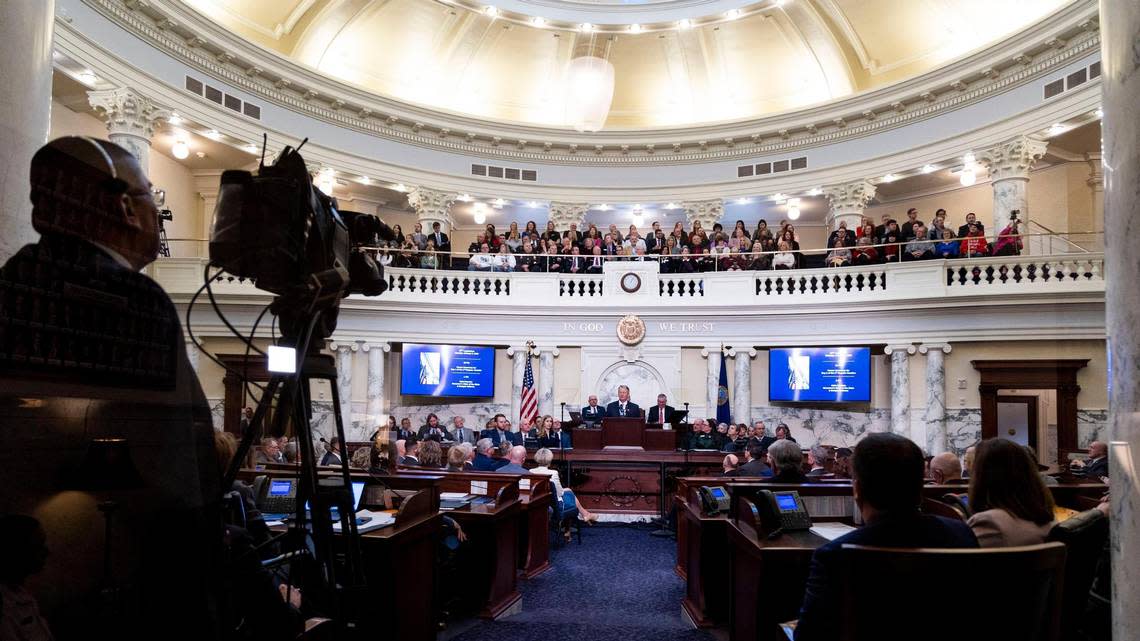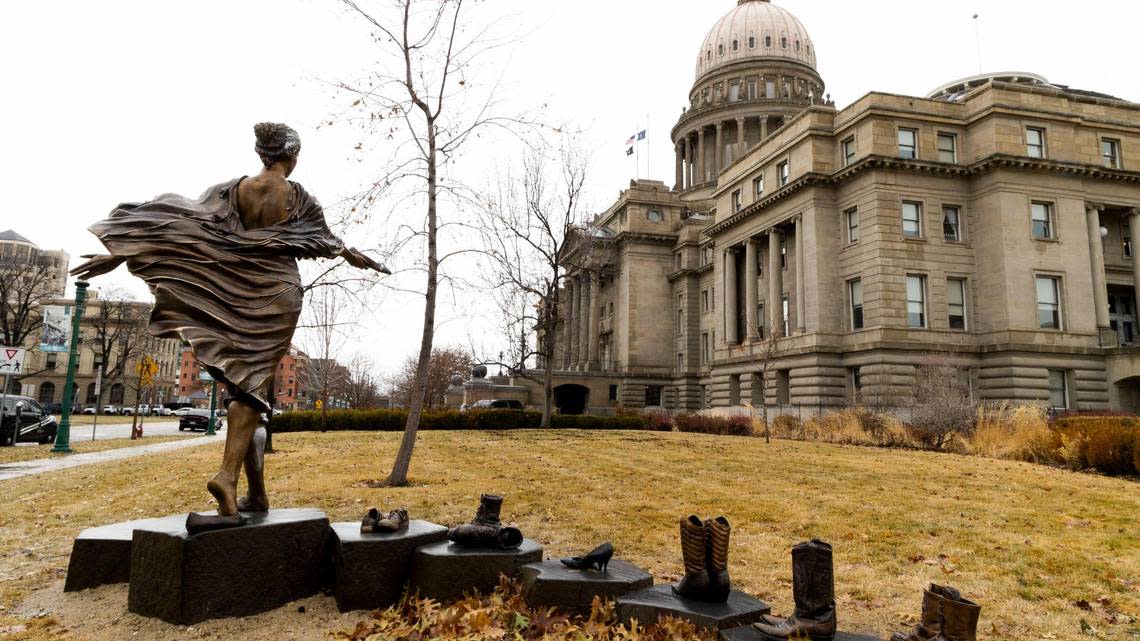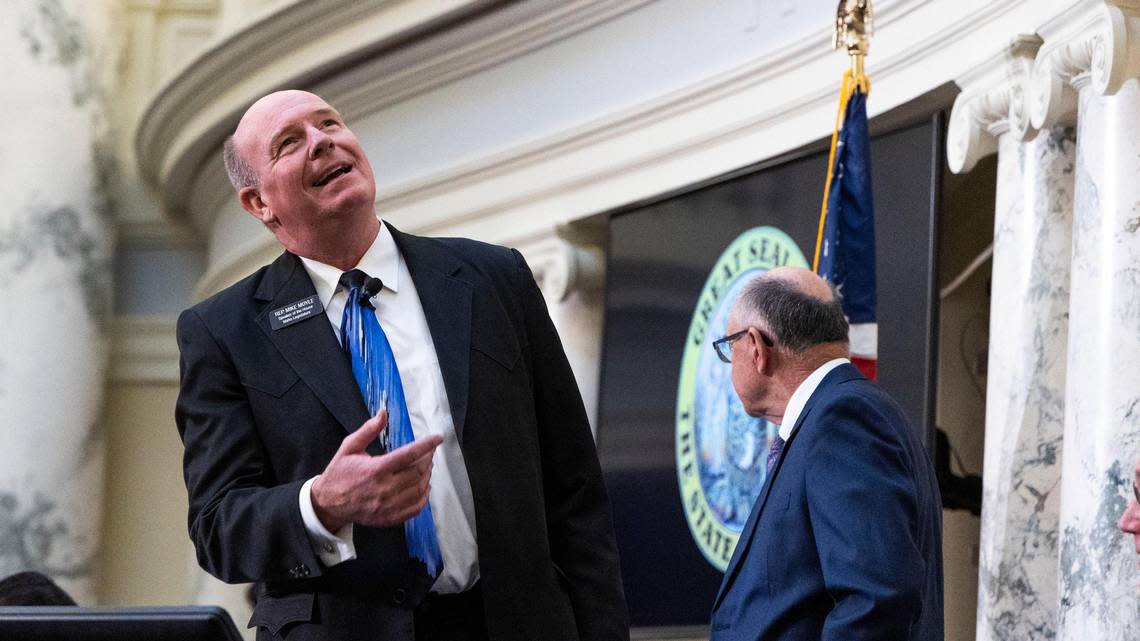Gov. Brad Little wants to boost Idaho’s teacher pay to rank among top 10 nationally
Idaho Gov. Brad Little on Monday asked lawmakers to spend an additional 16% on K-12 public schools.
Little, delivering the first State of the State address of his second term, proposed increasing starting pay for teachers to $47,477, which would put Idaho in the top 10 nationally.
The Republican’s proposals come after the Idaho Legislature in September approved a $410 million increase in education spending.
“We are not backing down on education,” Little said. “We are doubling down on education.”
After handily winning reelection last year, Little has set similar budget priorities to previous years, including record education investments along with infrastructure and public safety spending.

Little lays out education spending proposals
The $410 million education boost had broad support when it passed in September, but nearly half of lawmakers are new heading into this year’s session. They’ll decide how the money is spent.
Little proposed a $145 million increase in teacher pay across the board, a $6,359 annual increase per teacher.
Little said a November advisory ballot question — which passed with 80% support — affirmed that Idahoans support tax relief and education investments.
“The overwhelming support of our plan means, unmistakably, Idahoans expect us to support public schools,” he said. “Idahoans spoke loud and clear with their votes.”

The boost in starting teacher pay would put Idaho in the top 10 nationally, per a recent National Education Association report and the governor’s office. Idaho currently ranks 29th.
“When we show teachers we support them, we’re showing families their child’s education is our priority,” Little said.
Little also proposed an additional $27.9 million for health insurance benefits and $52.4 million for discretionary spending to schools. That would be the largest single-year boost in discretionary spending for schools in state history, according to the governor’s office.
Following Little’s speech Monday, House Speaker Mike Moyle, R-Star, hinted at other education priorities among lawmakers, including a change in the formula by which schools receive funding and directing public funds to private school and home school students.
“You’ve got a lot of opportunity for the new folks to have a say, so I think that was a good thing” about the special session bill, Moyle said.
The legislation also set aside $80 million for workforce development programs.
Little proposed creating an $80 million scholarship fund that would provide $8,500 to Idaho high school graduates attending in-state universities, community colleges or career technical or workforce training programs.
During his speech, Little recognized college students who wrote an article on the need to invest in students, and the governor recognized fourth and fifth grade students, and their teacher, from Centennial Elementary School in Nampa.
Little dubbed his new overarching spending plan “Idaho First,” a reference to the state’s top ranking among many economic indicators, such as job and revenue growth.
Superintendent of Public Instruction Debbie Critchfield in a statement said Little’s proposal would make Idaho’s teacher compensation more competitive with neighboring states.
Starting teacher salaries in Idaho are about $2,000 to $11,000 lower than in Nevada, Utah, Wyoming and Washington, according to the National Education Association report. Idaho’s starting pay is slightly higher than Oregon’s and about $7,000 above Montana’s, which ranks 51st in the country.
“I look forward to partnering with him and legislators on developing an education budget that delivers for Idaho’s students, parents, educators and schools,” Critchfield said.
Infrastructure spending meant to ease property tax
Building on last year’s boost in infrastructure spending, Little proposed another $200 million to improve local bridges. That would fund about a third of the state’s backlog in deficient bridges.
The governor recommended another $100 million in state funds to assist local governments with transportation projects and $225 million in federal funds to improve broadband infrastructure.
In total, Little proposed spending about $1 billion on infrastructure, from roads and bridges, to water and wastewater management, to improving capacity at state parks.
Little also signaled property tax relief will be a priority, a departure from recent years’ focus on income tax cuts and rebates. His budget sets aside $120 million in property tax relief, which is meant to be an ongoing fund.
Little did not propose a funding mechanism for the property tax relief, leaving it up to lawmakers.
“The debate will be good on that,” Moyle said. “The fact that the governor is willing to give more money as we try to find a solution to property taxes is a good thing.”
Little noted that spending on infrastructure is meant to lower property taxes.
“When we’re investing in drinking water and wastewater infrastructure, we save Idaho citizens the local taxes or fees they would otherwise pay in property taxes to cover those improvements,” he said.
The state is expected to finish the 2023 fiscal year — which ends in June — with a $1.5 billion tax revenue surplus.
In total, Little’s budget represents a 5% spending increase from the previous fiscal year, budgeting about $5 billion with more than $200 million left over, along with a $61.7 million increase in rainy day funds.
Ultimately, lawmakers will decide whether to adopt the governor’s recommendations. Last year, they adopted about 90% of his budget proposals.
Moyle, speaking Monday on behalf of the House GOP caucus, said the governor’s budget was well-received, and will likely find support among Republicans.
“The devil is in the details,” Moyle said. “We need to work together with him to find the solutions, and it’s not just going to be a rubber stamp.”

Democrats also praised Little’s budget, especially education, infrastructure and parks funding proposals.
“We are largely supportive of the governor’s proposal,” said House Minority Leader Ilana Rubel, D-Boise. “I think we’re going to play a pretty instrumental role in ensuring that these investments ... actually come to fruition.”
